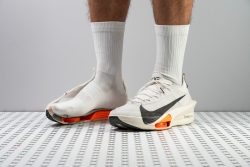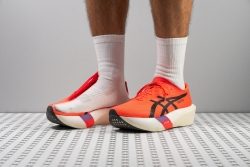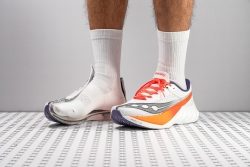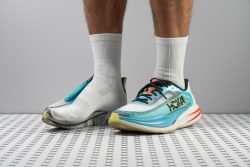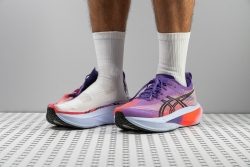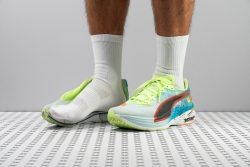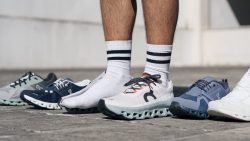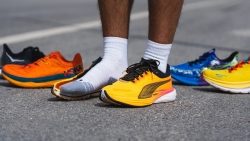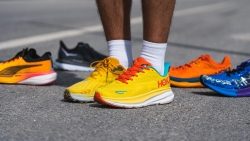7 Best Marathon Running Shoes in 2025

We buy shoes ourselves. We earn commissions when you buy through us, at no extra cost. Why trust us
Having a distance of 42 kilometers or 26 miles, a marathon is a long-distance race. You definitely need more than just a comfortable shoe for this effort.
It might be a max-cushioned cruiser that helps you train for a marathon, or a carbon-plated race-day shoe to shave off the minutes from your record, or a supportive shoe that won’t let overpronation stop you from finishing 42K.
We have tested marathon-ready running shoes to learn how they feel, fit, and perform, all to make sure you have the best options.
Additionally, since we want to perfectly assist you through the process of choosing the right marathon running shoe, we have created a guide that can get rid of any of your worries. Scroll past the top picks to read the guide.
How we test marathon running shoes
How do we know which running shoes can get you comfortably through 42 km and maybe even set a new record? Here is our review process:
- We, dedicated testers, run in each pair before delivering our feedback.
- Every shoe gets sliced and measured at our RunRepeat testing lab on over 30 different parameters. These help us translate features like energy return, shock absorption, durability, flexibility, etc., into data.
- We purchase all the shoes we test with our own money to prevent bias. We only believe in transparent reporting of data and experience.
Best marathon running shoes overall
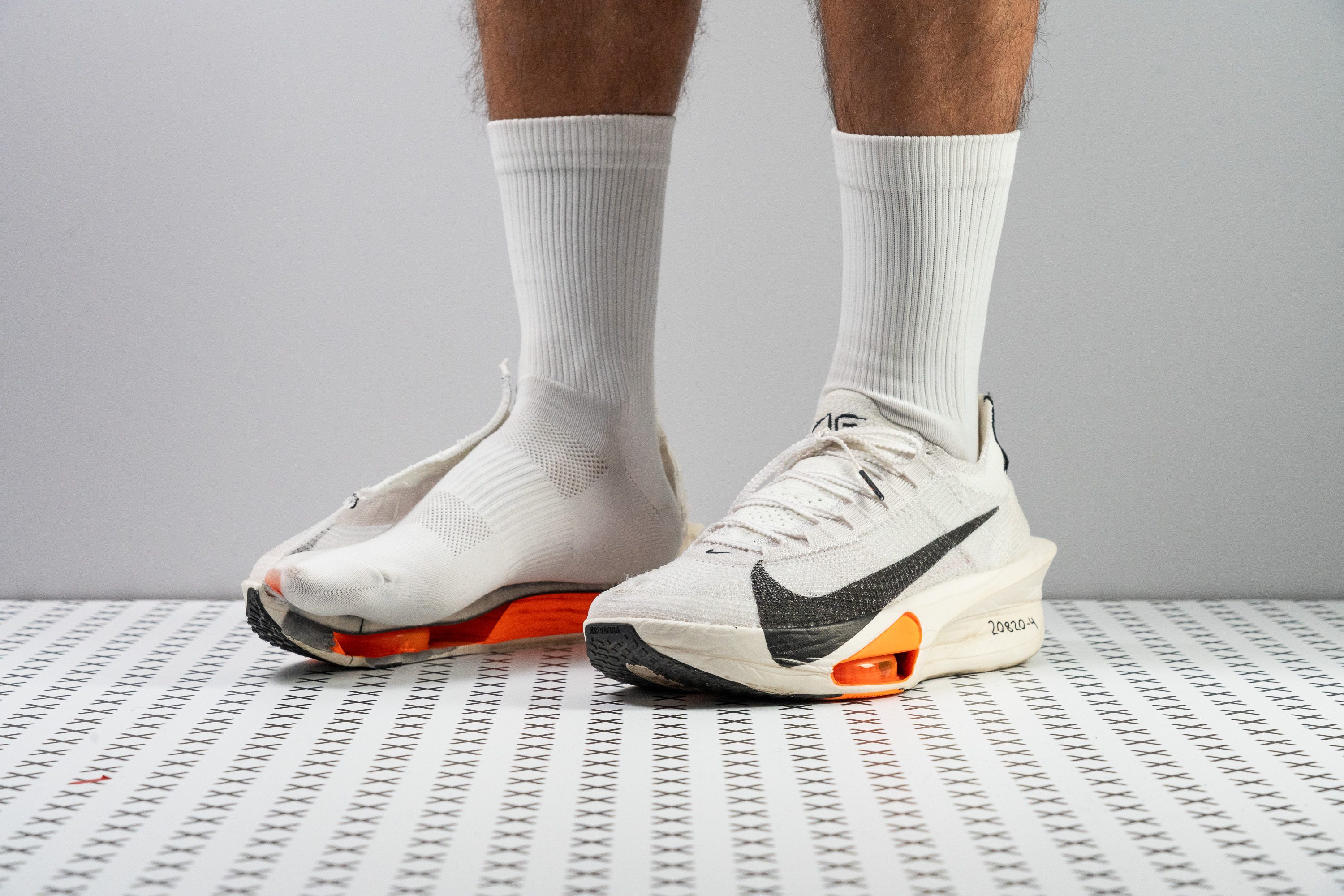









































































What makes it the best?
Hours of running and extensive lab tests validate that Alphafly 3 dominates marathon running shoes. It has boundless energy, unmatched comfort, and a stable ride uncommon for supershoes.
We can confidently say that the Alphafly 3 is among the best—if not the best shoe—when it comes to propulsion. The carbon fiber FlyPlate integrated into the midsole makes it 144.7% stiffer than average—the level of stiffness for smashing records. Adding to the responsiveness is the Air Pods in the forefoot. Truly, a heavenly ride to behold.
A massive stack of soft yet responsive ZoomX foam makes the ride forgiving and enjoyable. The cut-in-half shoe reveals two layers of cushion, each with a specific purpose. Our durometer measured the bottom layer at a plush 18.1 HA for comfort, while the top layer is a firm 29.3 HA for stability. This keeps our feet in check, especially towards the end of a marathon where our strides tend to change.
With the upper scoring a perfect 5/5 on our breathability test, the shoe is suitable for any weather—ready for obliterating PBs in the heat. Another surprising element is its light 7.1 oz (201g) build despite its size.
At $285, Alphafly 3 tips the scale in terms of price. Though we believe it’s worth the investment, budget-conscious runners can explore cheaper, high-performance shoes elsewhere.
Pros
- Remarkably lightweight despite its broad size
- Best-in-class breathability
- Excels in the marathon distance
- Repositioned Air Pods offer a better ride than the v2
- ZoomX foam delivers massive energy return
- Aids in forward momentum, especially when legs begin to fatigue
- Better than ever for 5K/10K racing
- Finally smooth transitions!
Cons
- Heel strikers might wear down the outsole quickly
- The arch could still be a challenge for some
- The sock-like tongue might not suit everyone
Marathon running shoes with the best energy return




























































What makes it the best?
Adidas Adizero Adios Pro 4 exceeds the standard with its extraordinary responsiveness, which helped us achieve peak performance. Our lab tests and runs can confirm it offers the best energy return for marathon running, especially with its long-lasting outsole. Its plush cushion and carbon-infused rods release consistent energy that prevents fatigue, while its wide forefoot keeps us stable.
The midsole seamlessly blends a soft mega-stack with its Energy Rods 2.0, which translates into insane responsiveness without sacrificing comfort. AP4 emerged 51.3% stiffer than average on our flex test, confirming its responsiveness without feeling as stiff as other supershoes. Testing for the midsole’s energy return, the forefoot impressed us with a whopping 80.3% vs. the 60.5% average.
Our feet felt good even during endurance runs, backed up by shock absorption scores of 142/117 SA in the lab. Equipped with a wider forefoot and a small Continental rubber underneath it, our runs felt steady and secure during takeoffs. We measured the forefoot to be 4.5 mm wider than average, promoting stable landings for forefoot and midfoot strikers.
Amazingly, the LIGHTTRAXION surprised us with durability. Despite being 48.2% softer than average, it's more durable than the standard in our Dremel test by showing minimal wear.
Unfortunately, the 80.4 mm heel is 10.3 mm narrower than average. Rear strikers may feel some tightness or instability in this area.
Pros
- Softer, bouncier Lightstrike Pro foam
- Maintains the same price
- No more heel slippage
- Versatile from 5K to marathon distances
- Durable outsole with outstanding grip
- Fantastic for midfoot and forefoot strikers
- Improved for faster runners
- Comfortable, gusseted tongue
- Lighter than Adios Pro 3
Cons
- Unstable for every heel striker
- Narrow, tapered toebox
- Upper lacks breathability
- Midsole loses bounce quicker than AP3
Best lightweight marathon running shoes




















































What makes it the best?
We’re in awe of how much power and cushion the ASICS Metaspeed Edge Tokyo holds in its minimal package. It delivers consistent energy and oozes comfort from mile 1 to 26 in our runs. This PR-chasing racer is a rare breed, making it our top lightweight marathon running shoe.
At an ultra-feathery 5.6 oz (159g), it’s significantly lighter than the 7.3 oz (207g) average of competition shoes we tested! Being 23.2% lighter than the average racer, its lower weight reduces fatigue and really makes a difference during endurance runs. Together with its well-ventilated upper, scoring 5/5 on our lab breathability test, it soothes us during heated races.
With a soaring 38.9/32.0 mm stack height, this pair provides a significant amount of cushion that mutes the impact of landing. Not only that, we recorded exceptional shock absorption scores of 146 SA (heel) and 132 SA (forefoot), providing immense relief in the latter miles.
Delightful comfort is matched by insane responsiveness thanks to the carbon plate and its FF Leap midsole. Each stride launches us forward, with solid energy return scores of 78.3% (heel) and 76.8% (forefoot).
With minimal reinforcements and maximum cushioning, this shoe isn’t the most stable option. Marathoners seeking control and guidance should try alternatives.
Pros
- Light as a feather
- Excels at any distance, from 5K to the marathon
- Elite-level traction
- New FF Leap midsole is super responsive
- More stable than the Metaspeed Sky Tokyo
- Plush forefoot
- Excellent upper
- Classic rolling feel from curved plate
- Better than Metaspeed Edge Paris in every way
Cons
- Price increase
- Narrow fit
- Not stable
Best marathon running shoes for heel strikers
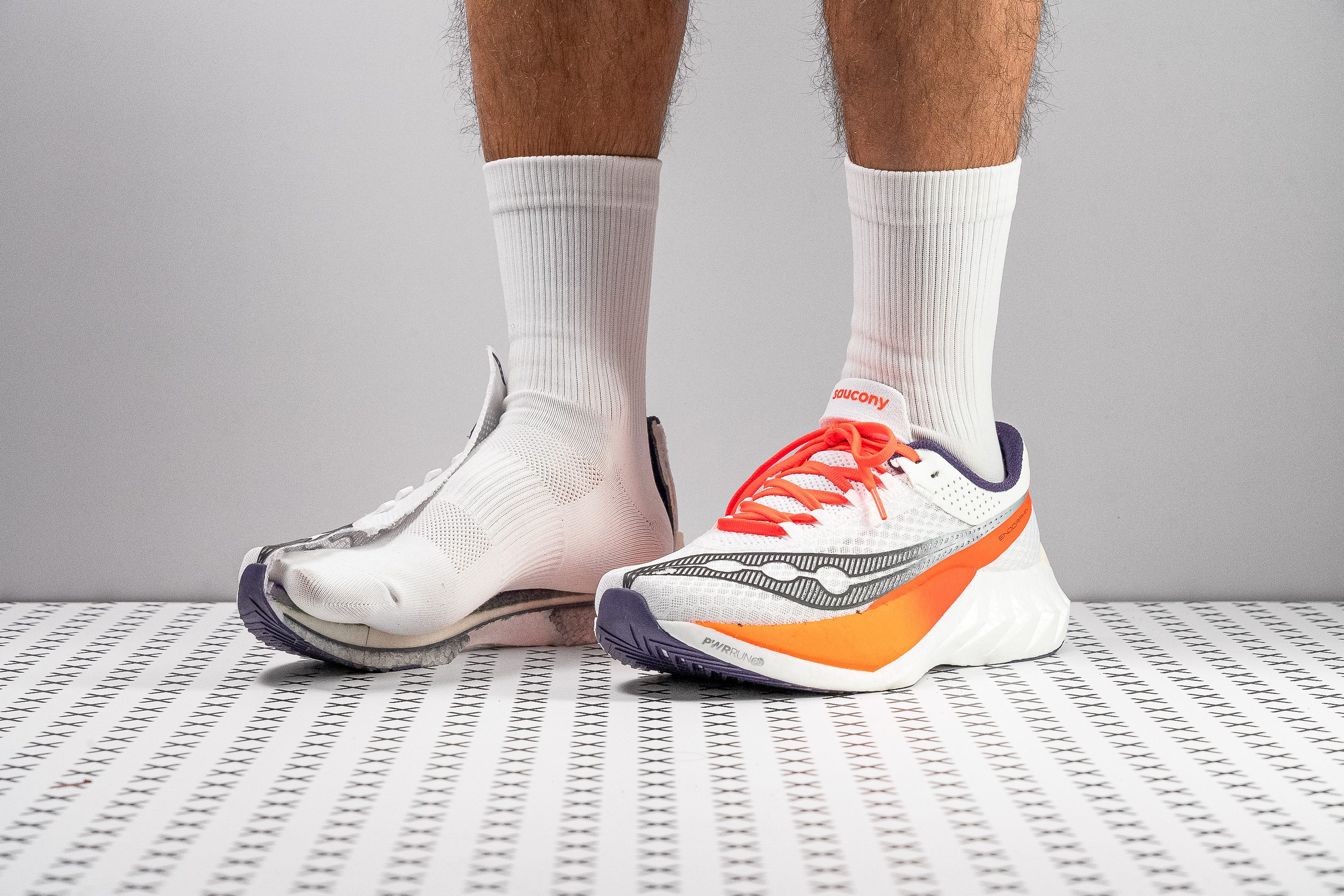
























































What makes it the best?
During our test runs, Saucony Endorphin Pro 4 delivers a forgiving yet stable and responsive ride—making it our ultimate marathon shoe for heel-strikers. It has supreme cushioning, a vibrant midsole, and an airy sensation that makes miles 1 to 26 fast, comfy, and more importantly, enjoyable.
In our lab, EP4's heel stack measures 38.1 mm, offering generous cushioning for impact absorption. With a 9.5 mm drop, it facilitates smooth forward rolls, particularly for heel-strikers. Despite its height, the shoe maintains stability due to its dual-density midsole configuration: a soft and bouncy 18.5 HA top layer, paired with a balanced 22.0 HA bottom layer for added support.
Embedded within the foams is a rigid S-shaped carbon plate, exhibiting 137.5% greater stiffness than average, as revealed by our bend test. This heightened stiffness yields a springboard effect, propelling us forward with massive energy return. Additionally, its high torsional rigidity effectively minimizes lateral shifts.
In long-distance running, a light and well-ventilated shoe is crucial to avoid additional weight and hotspots. Our lab confirms EP4 is a light 7.8 oz (220g) with a super light feel thanks to its breathable upper that scored a flawless 5/5 in our smoke and light tests.
Those with narrow feet may not achieve the preferred race-ready fit in the forefoot area. Our caliper reveals it’s 5.5 mm wider than average.
Pros
- Durable upper and outsole
- Spacious upper fit
- Enhanced midsole comfort
- Great value at $225 for a supershoe
- Versatile across all paces
- Ideal for heel strikers
- More stable than ever
Cons
- Slightly heavier than v3
- Less suited for forefoot strikers
- Competitors may feel quicker
Marathon running shoes with the best shock absorption
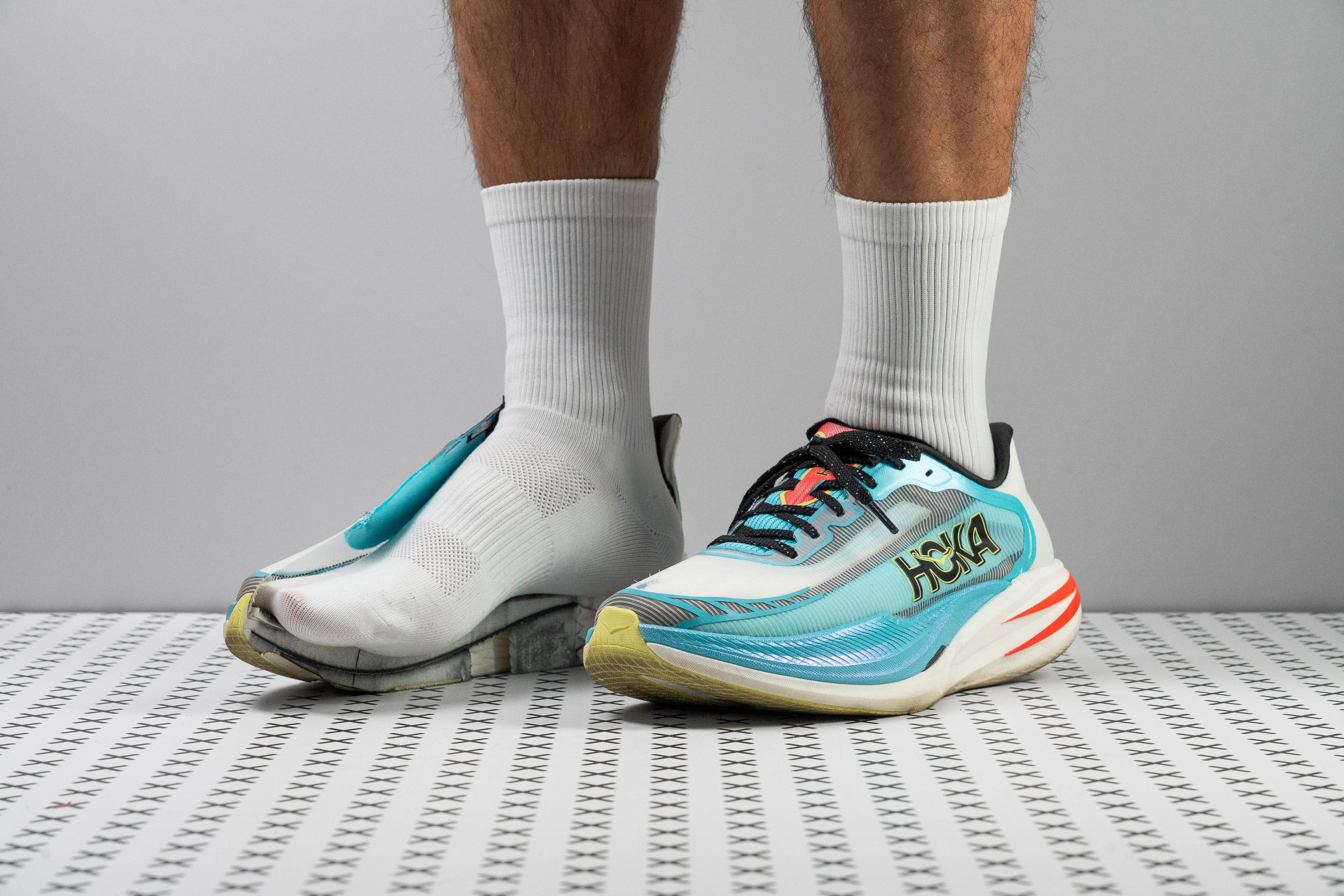

















































What makes it the best?
The Hoka Cielo X1 2.0 is an airy, power-loaded pair focusing on speed and cushioning. Lab results validate its strong performance, impact protection, and bold rocker are consistent through the miles; we can’t help but award it with the best shock absorption among marathon running shoes.
Our runs feel effortlessly faster in this racer, and every landing feels well-cushioned, helping preserve our legs until the last few miles of the marathon. To put a number to it, we tested for the cushion’s shock absorption in the lab, and the results made our jaws drop: a massive 160 SA and 108 SA in the heel and forefoot, respectively. Both figures are above average, together with the generous 38.8/28.1 mm stack protecting our joints.
In terms of sustaining speed, Cielo makes it effortless with a solid 75.9% energy return in the heel and an even higher 78.4% in the forefoot. Its rocker design and stiff carbon plate encourage efficient turnover and strong momentum, too.
This shoe is meant to race with its feathery 7.3 oz (208g) weight and its breezy upper. It scored the highest 5/5 on our breathability test, meaning hotspots and blisters won’t be a problem.
However, its intense curvature might feel overwhelming for others. Runners who prefer a more classic ride should opt for a less aggressive set-up.
Pros
- Much lighter than v1
- Plush and responsive PEBA foam
- Top-tier breathability
- Forked plate adds heel flex
- Comfort-focused heel padding
- Outsole durability is not a concern
- Improved upper and laces
- Works well from 5K to the marathon
- Premium TPEE insole
Cons
- Pricier than most rivals
- Rocker can feel too aggressive
- Narrow-fitting upper
Marathon running shoes with the best traction
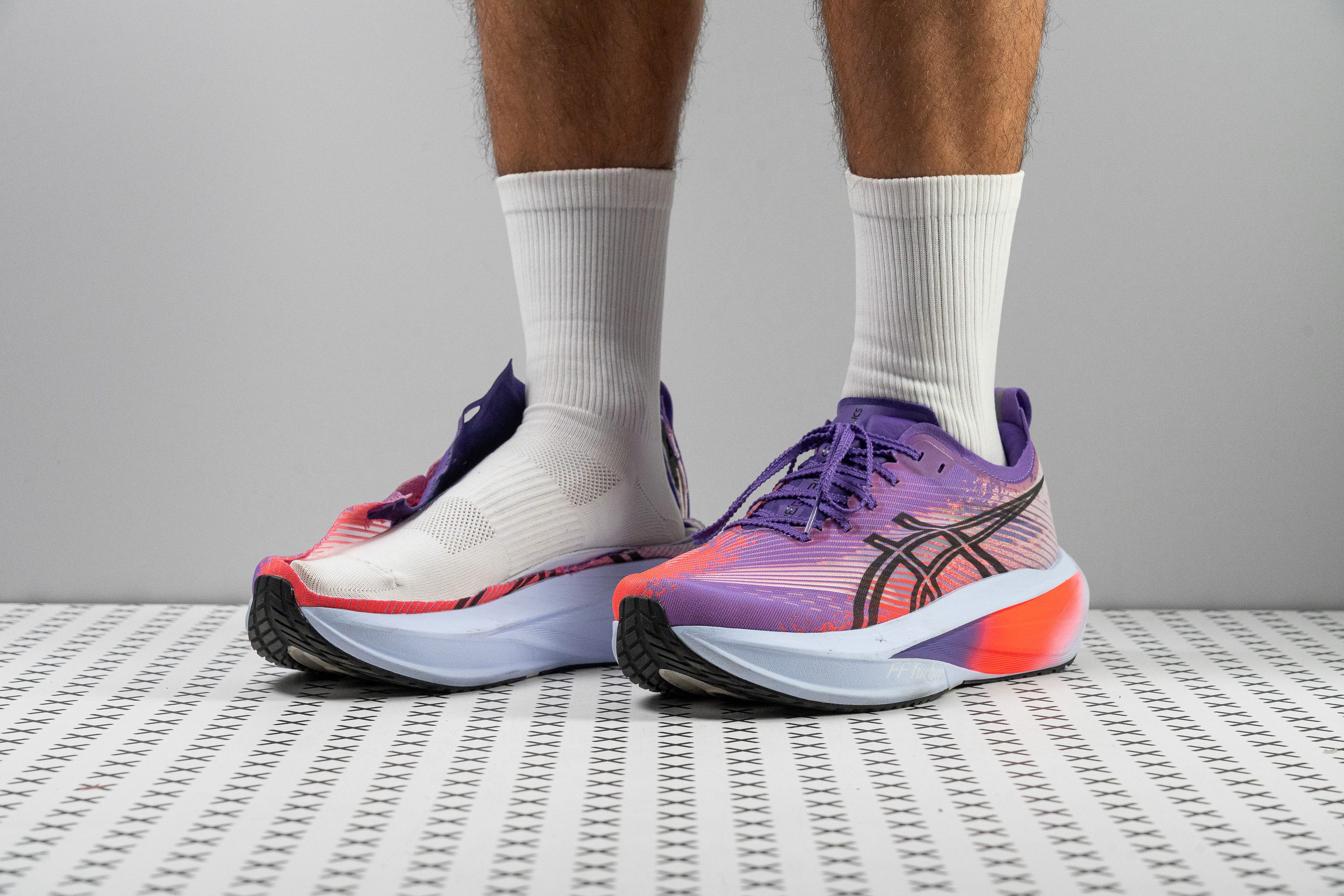
















































What makes it the best?
The ASICS Megablast offers a strong ground hold that very few shoes can match. Undeniable on foot and proven in the lab, it’s our marathon running shoe with the best traction. In addition, it offers top-level shock absorption in a light package, making it perfect for endurance runs.
Featuring the stellar ASICSGRIP, we knew this shoe would do well in our wet-condition test. Yet Megablast managed to blow our minds with its ultra-grippy 0.80 score. For reference, that’s 70.2% better than the standard in our lab!
Megablast continues to surpass the average in terms of cushioning. It features a colossal 45.1/35.2 mm stack, ensuring even heavier runners won’t run out of foam. Meanwhile, we achieved outstanding scores of 160 SA in the heel and 144 SA in the forefoot in our shock absorption test, offering solid leg protection that’s truly a relief in the final miles of marathon distances.
Despite its maximum height, it manages to keep its weight to a minimum. At 7.8 oz (218g), it’s 17.7% lighter than the average, which boosts our agility and helps prevent the early onset of fatigue.
Unfortunately, Megablast has limited rubber coverage in the outsole, so we recommend avoiding unpaved surfaces to prolong the shoe’s lifespan.
Pros
- Outstanding energy return
- Exceptional impact protection
- Durable, grippy outsole rubber
- Astonishingly low weight
- Performs at any pace and distance
- Breathable, lightweight upper
- High-quality materials from heel to toe
- Suitable for all footstrikes
- Top performance without a carbon plate
Cons
- Extremely expensive for a training shoe
- Limited outsole coverage
- Poor toebox durability
Marathon running shoes with the best value for money
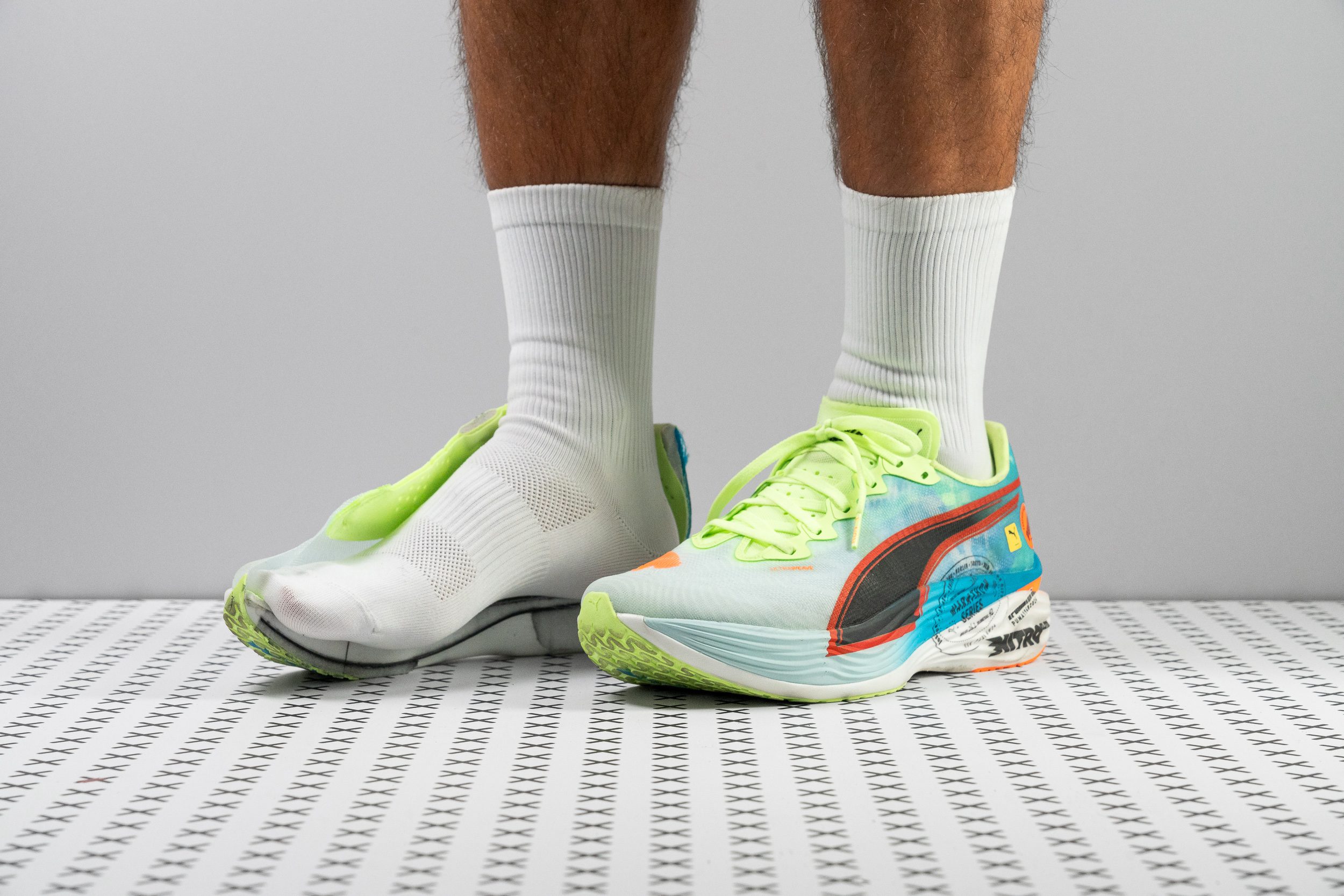





























































What makes it the best?
The PUMA Deviate Nitro Elite 3 sets apart from other speedy supershoes we tested because of its lightness, comfort, and more accessible price point. At $230, its speed and agility can match or even exceed other more expensive racers we’ve tested in the lab, making it our best-value marathon running shoe.
Lifting our feet repetitively over 26.2 miles felt less of a burden thanks to the shoe’s airy 7.2 oz (204g) build, 23.0% below average. The ride feels effortless thanks to the midsole's electric energy, made possible through its stiff and curved carbon plate, with the rocker shape boosting turnover. Our bend test confirms it’s 78.5% more resistant than average, explaining its explosiveness.
Despite the rigidity, DNE 3 feels highly comfortable and bouncy, keeping our legs fresh with its thick slab of superior Nitro Elite foam underneath. Our caliper reveals a massive 39.2 mm stack under our heels, mostly where our tired feet strike towards the end of a marathon. Additionally, we found a plush 15.1 HA foam right under our feet for less impact and a more balanced 18.3 HA base layer for stability.
However, the shoe’s narrow build may still feel unstable for heel strikers and the steep 10.6 mm drop may feel uncomfortable for forefoot strikers. We believe this shoe shines best for midfoot strikers.
Pros
- Superb Nitro Elite foam
- Breathable, lightweight upper
- Extremely responsive
- More affordable than most supershoes
- Outstanding grip
- Great comfort for a racer
- Major improvements from v2
- Fast, agile, race-ready performance
- Fantastic tongue
Cons
- Not the best for heel strikers
- Durability concerns
- Lacks stability for some runners
Many factors come into play when running a marathon. When it comes to shoes, we will cover them all.
This guide is aimed at an average runner and when we say average we mean someone who isn’t planning to run a marathon in a barefoot running shoe or a daily trainer. While both are possible and many runners do it, here we focus on marathon shoes per se.
What to look for in marathon running shoes
Here’s what to look for in marathon shoes and keep in mind we elaborate on every little detail down below:
- Comfort. Marathon shoes must be comfortable, which means your toes should not be cramped, your heel should not be slipping and you should not be experiencing a lace bite. No hotspots, no chafing!
- Soft yet responsive cushioning with good shock absorption. Marathon shoes should be higher off the ground and definitely not barefoot or minimalist.
- Breathability: especially if you have sweaty feet or are running in hot weather.
- Durability. Depending on whether you’re using the shoe for the race only or for the training as well and, maybe even multiple races, we can focus on outsole durability but also midsole durability (so that it does not bottom out).
- Weight: ideally, less than ~270g.
There are a few more details that you could look for in marathon shoes but those depend on your form, current or past injuries, foot condition, etc. Here, we’re talking about a rocker, carbon or nylon plate, stability (if you’re overpronating), and rubber placement on the outsole, which depends on your foot strike.
ALL aspects of comfort in marathon running shoes
Easier said than done because so many things come into play when it comes to comfort. It’s not just about finding the right size but also making sure the shoe fits properly. Here’s a list of our suggestions on what to pay attention to:
- Make sure there’s no chafing and no hot spots.
- Look for shoes that offer a superb lockdown. This means your heel does not slip and your feet don’t slide inside the shoes from one side to another.
- Avoid lace bite. You can do this by tightening the laces less (if it does not spoil the lockdown) or looking for shoes with a thicker tongue.
- Your toes should not be cramped. While a tighter and more aggressive fit is welcome in race shoes, this usually applies to shorter distances. Logging 42km in a tight shoe can end up in pain, bleeding, blisters, etc.
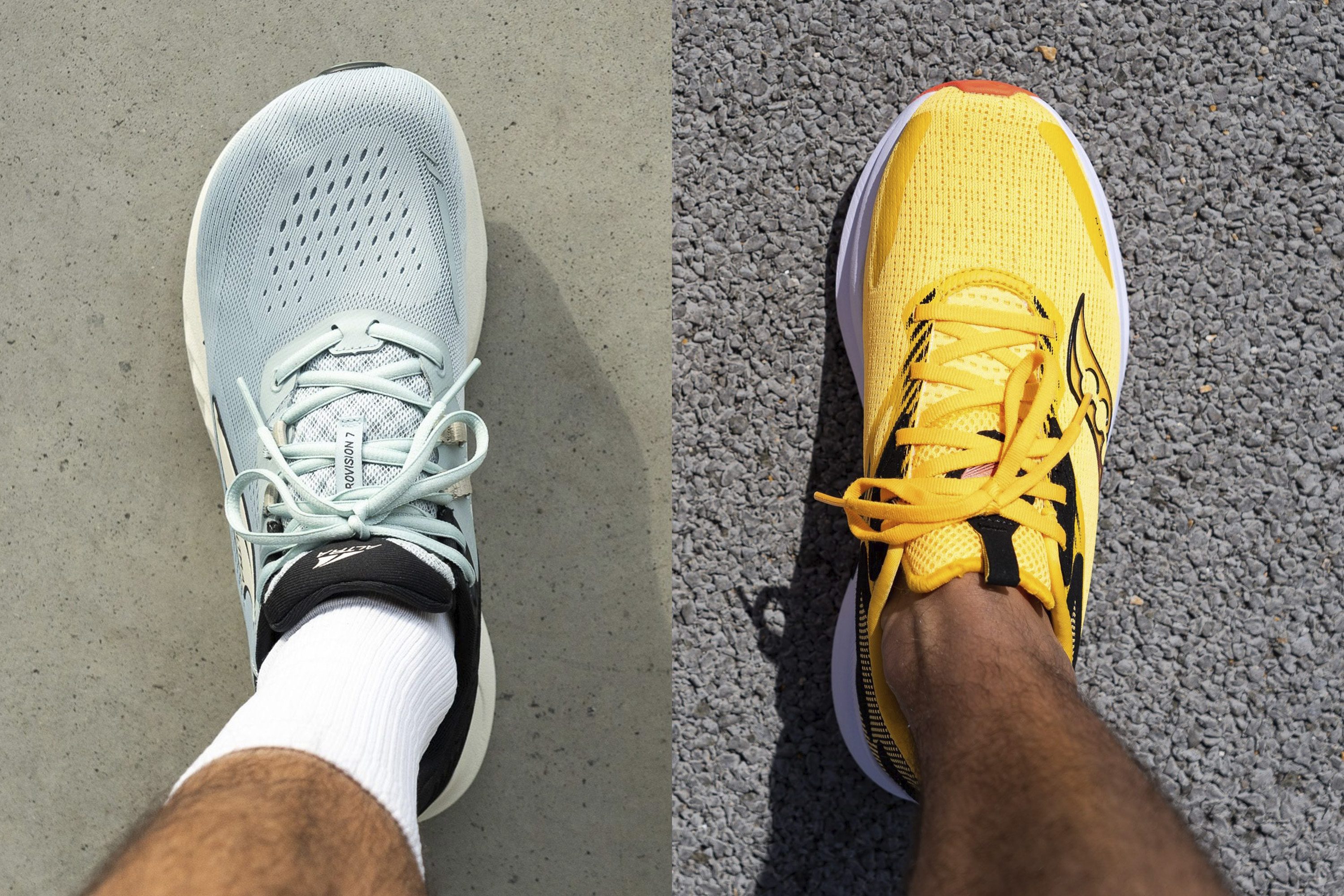
To nail the width of the shoe and the toebox, we advise understanding different shapes of feet (toes) and what works for them.

As you can see in the image above, there are toes that could tolerate very pointy toeboxes, while there are toes that really need less tapering, which means more room around the big toe.
In our lab, we measure the width of the shoe in 2 places: where it’s widest (around the ball of the foot) and at the big toe. These 2 numbers can tell us not just how wide the shoe is where it’s widest (the most frequently addressed width) but also how pointy the toebox is.
We can make these measurements thanks to our special gel that is poured into the shoe, frozen, and we end up with a gel mold that perfectly resembles the interior of the shoe
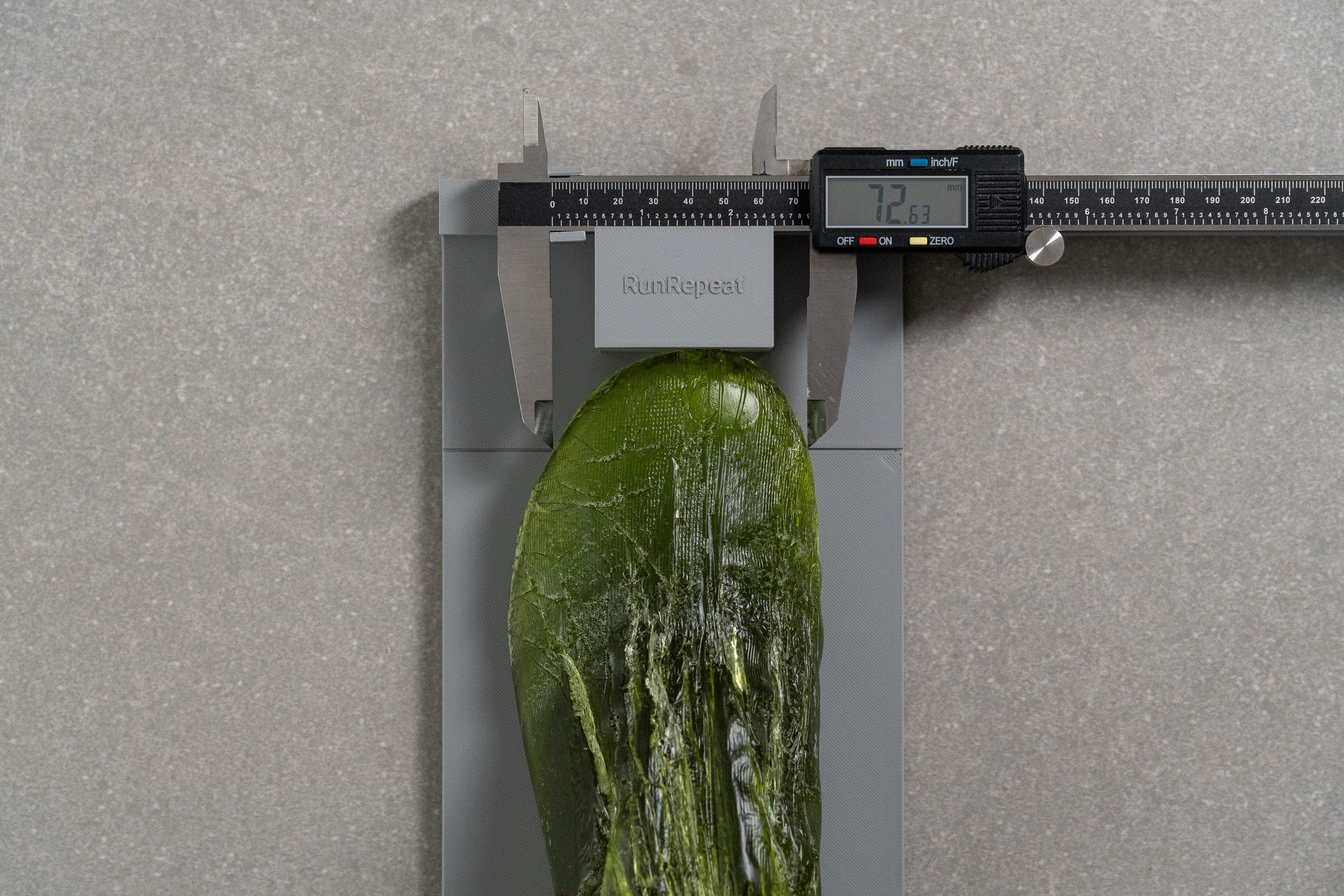
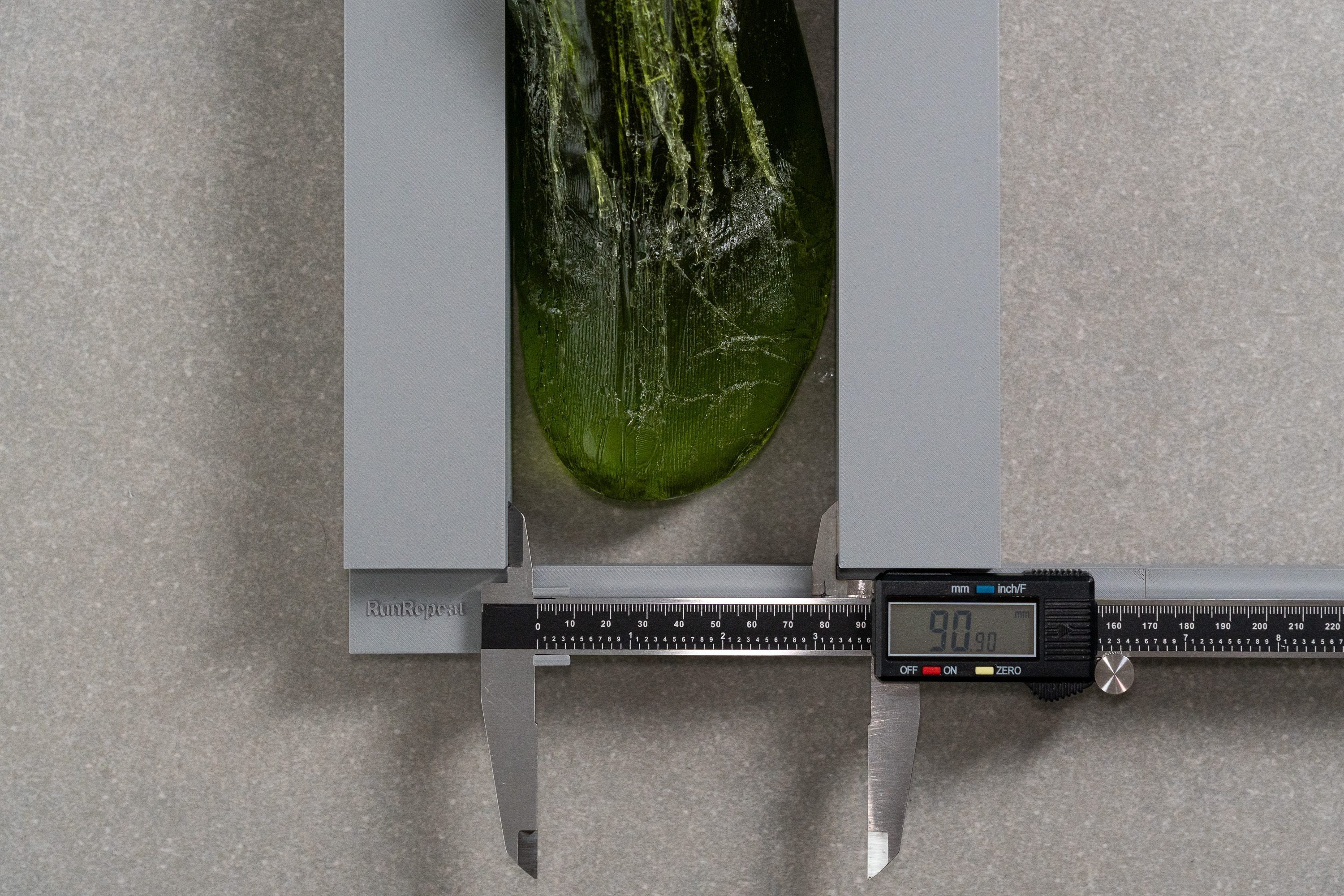
Based on the shape of your toes, you can look for marathon running shoes that offer more width in one place or another.
This gel mold fills the toebox perfectly so it's great for measuring the height of the toebox as well.

|
Also, some uppers have more give, while others are stiff and will not allow your toes to wiggle. If you’re curious about upper materials and their pros and cons, read our guide on running shoe uppers. |
It’s all about the midsole: find the best one
How big should it be?
- We recommend a heel stack height of at least 30 mm.
What type of foam?
- Soft(er) and responsive.
Let’s dive into the details.
How tall are marathon running shoes?
When it comes to the stack height, we measure both heel stack height and forefoot stack height and we do it according to the guidelines from WorldAthletics. This also allows us to calculate the accurate heel drop.
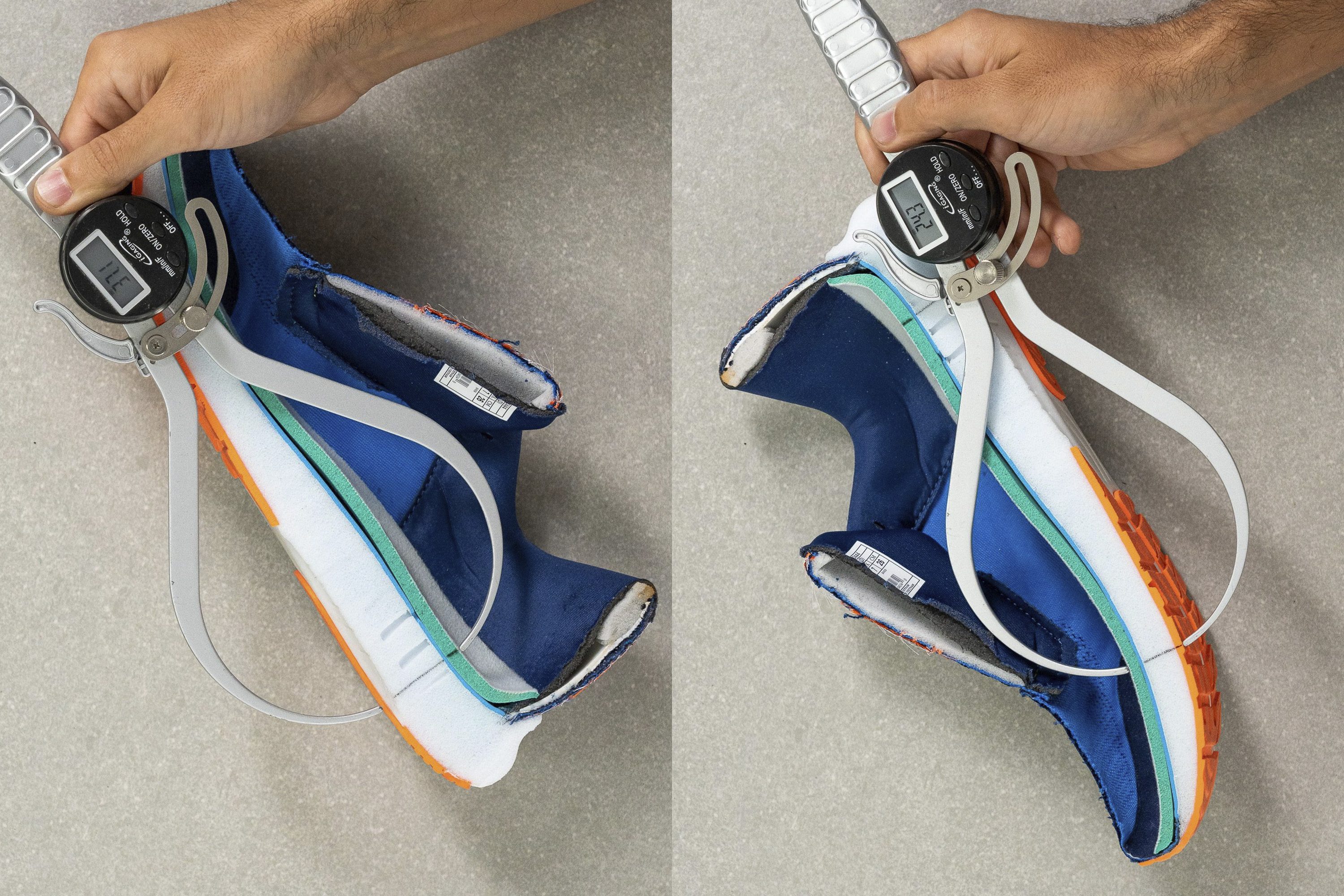
For running marathons, we recommend at least 30 mm in the heel. Of course, it’s possible to run a marathon in a racing flat (very low-to-the-ground shoes) but we’re talking about general guidelines and they say 30 mm.
WorldAthletics also puts the limit at 40mm for a shoe to be legal for official competitions.
Subtracting forefoot height from the heel height gives us a heel to toe drop. This number tells us, obviously, how higher the heel sits when compared to the forefoot. There are shoes that are flat (have a 0mm heel drop) and there are shoes that have a heel drop of 16mm.
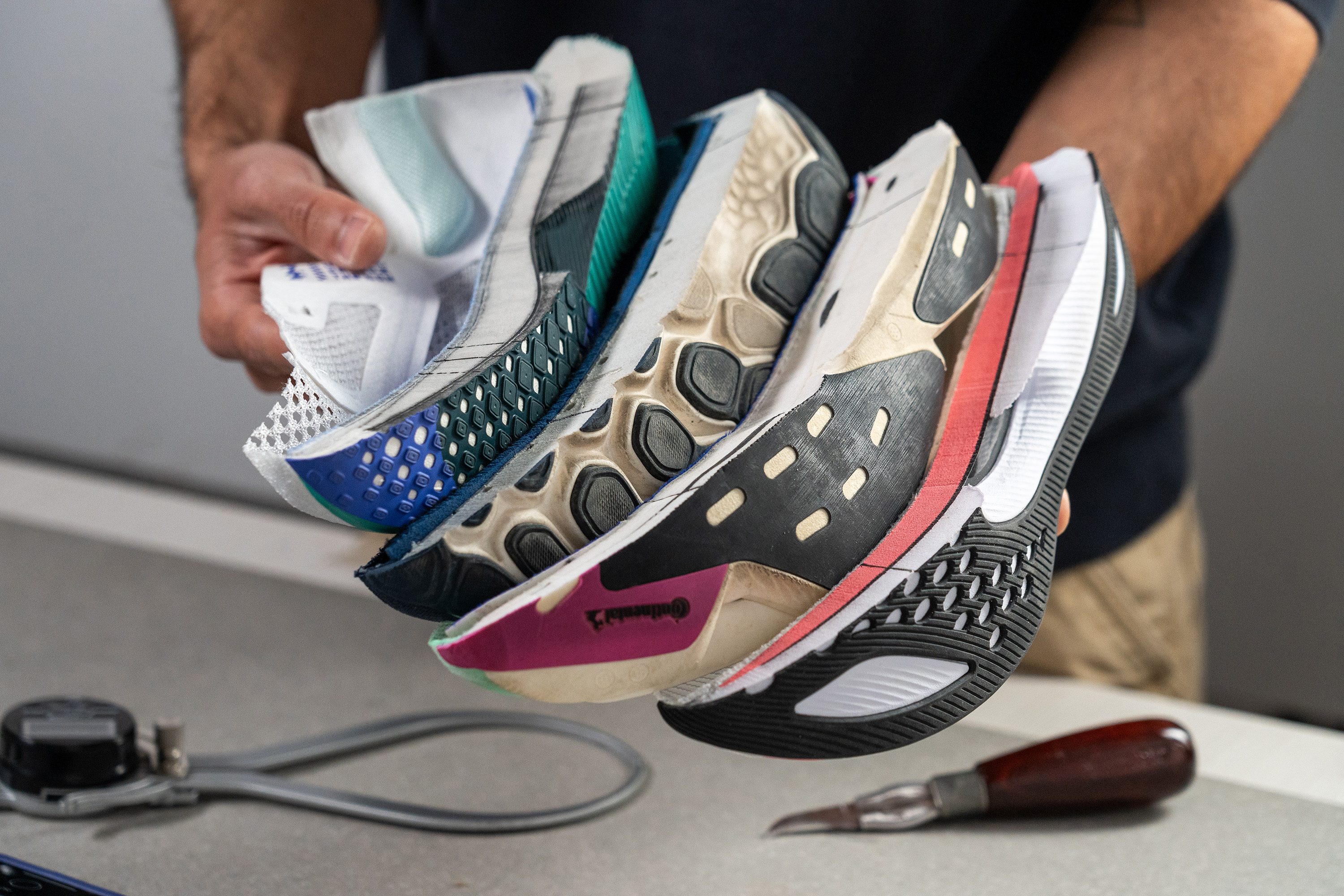
Now, this drop matters because it can significantly influence how you run and which muscles you use more. Zero drop uses our feet muscles a lot, lower drops (5-6mm and lower) activates the calves and Achilles, while higher drops (for example, 8mm and above) uses thighs and hip muscles more.
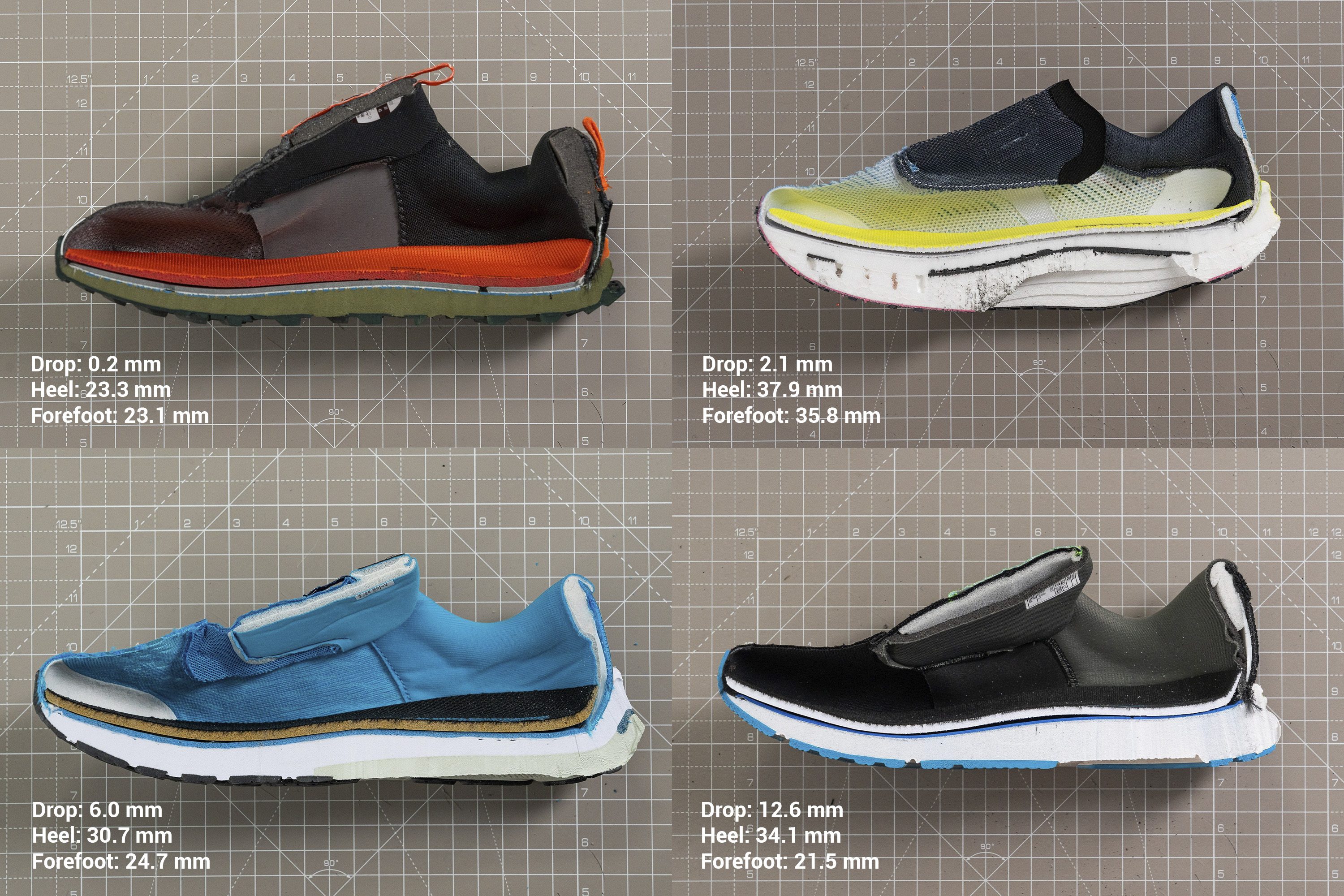
Going for a wildly different heel drop with no preparation can result in injury. Beginners are usually recommended to go with ~10mm drop because it’s a standard one. And some runners have shoes with different heel drops in their rotation, which can be great for working on running form and muscle strengthening.
|
We’ve covered everything there is to know about heel drop in our Ultimate guide on heel drop. |
On our website, you can filter for different heel drops. Usually, for longer distances, a higher heel drop is recommended because even foot strikers get tired and tend to land on the heel. More cushioning at the heel means softer landings. For context, here are heel drops of best-rated marathon shoes:
Which foam is the best for marathon shoes?
The one that's responsive and great at dampening the impact forces at the landing. This translates to foams with high energy return and high shock absorption. Some runners tend to focus on softness though, which plays a big role in the overall comfort, but performance-wise, we recommend focusing on shock absorpiton and energy return.
Very soft foam experienced in New Balance Rebel v4
These midsoles are best avoided. We recommend looking for responsive foams. These foams launch our feet up, which enables the shoe to propel us forward when running.
Very squishy and unstable Alphafly 3 at cornering
It is essential to find the foam that works best for you because it can have a very big impact on your performance and recovery. We wrote a guide about foams in running shoes and it’s the most detailed guide out there!
However, if you’re currently focusing on softness, you can always check the durometer numbers in our reviews. We cut shoes in half and stick a durometer in the foam to measure how firm it is.
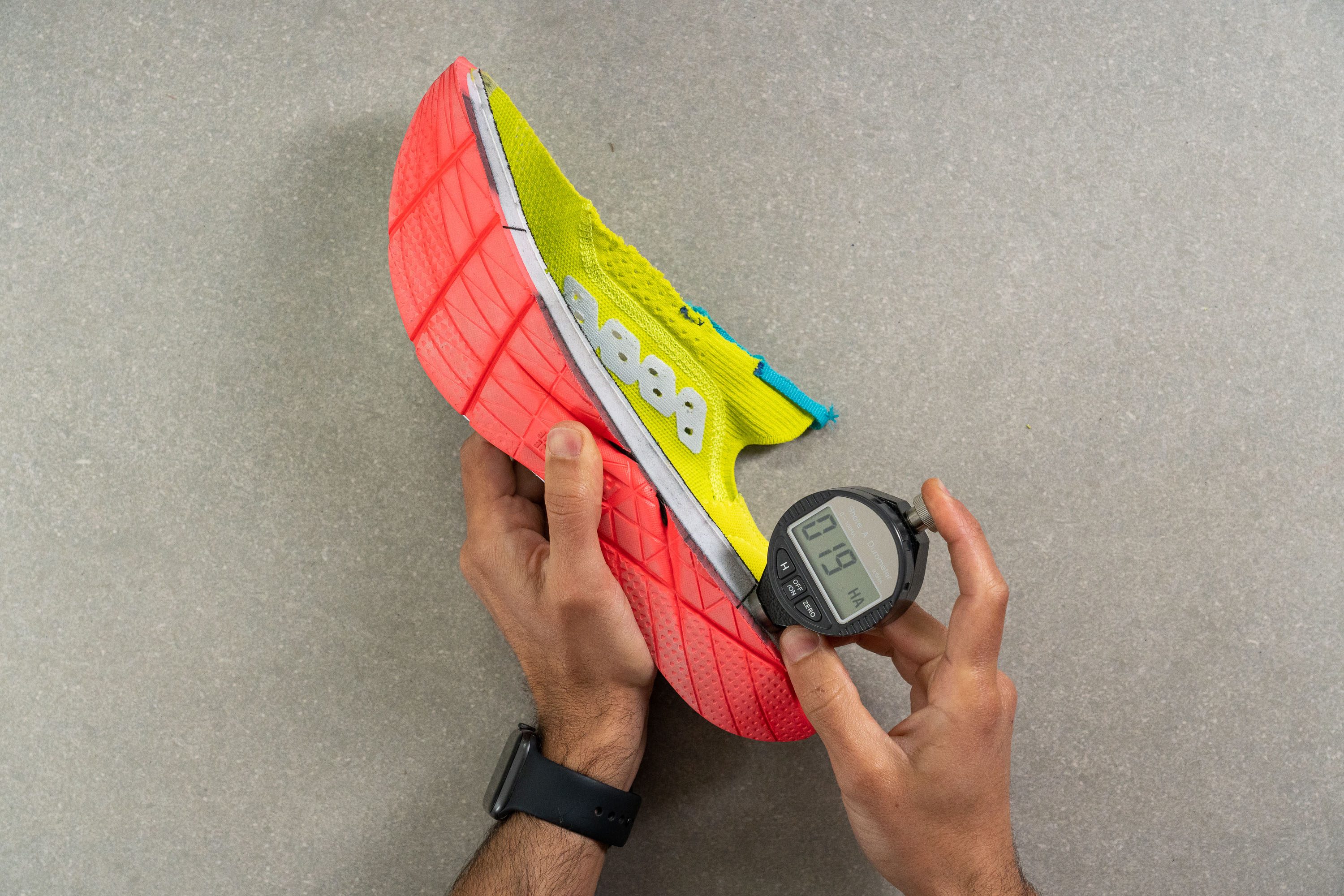
But, to run the marathon efficiently we recommend looking for foams with a high shock absorption and high energy return!
Energy return of marathon running shoes
Even if you haven't been aware of energy return previously, when the Nike Vaporfly 4% hit the news, it felt like energy return was what everyone was talking about. This 4% improvement was also confirmed by the researchers. Energy return is a metric that tells us how responsive the shoe is, or how good it is at bouncing back once it has been squished at the landing.
Testing energy return and shock absorption in RunRepeat lab
The higher the result in %, the better the energy return (or the bouncier the midsole!). When running marathons, which are quite long distances, this feature becomes insanely important because low energy return would cause runners' legs to work more, which would lead to (premature) fatigue.

It would be wise to keep in mind that this number does not guarantee better race times overnight. It's only one piece of the puzzle, where forefoot strike, runner's weight, stiffness of the shoe, etc., must be taken into account as well. But, it is a big piece of the puzzle and a very important one. To learn all the details about energy return, we recommend heading over to this guide Energy return in running shoes explained immediately!
Shock absorption of marathon running shoes
When it comes to running marathons, it's best to look at the shock absorption and energy return at the same time. Shock absorption is literally about that: absorbing the shock. Some midsoles are better at that, which means they successfully dampen the impact forces so that less stress is sent to the runners legs. This is crucial for running marathons.
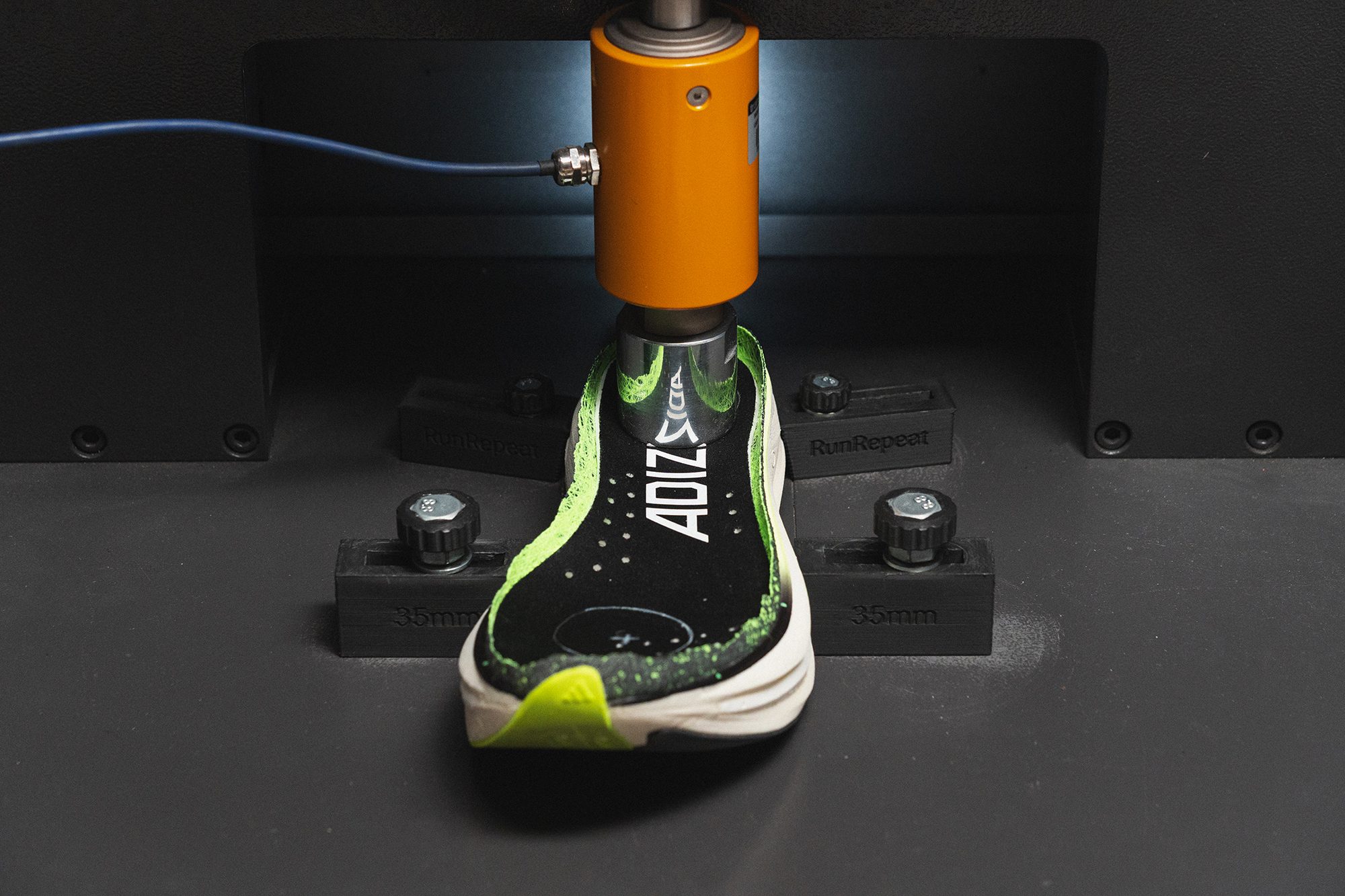
Shock absorption is tested together with energy return, following the ASTM F1976-13 methodology, and the result is given in SA. The higher the SA, the better.
Some running shoes, like daily trainers or running shoes for beginners, have moderate (average) shock absorption, which makes sense for such purposes. For marathons, on the other hand, we recommend going for higher numbers given in SA.
Weight of marathon running shoes
The lighter the better, of course. However, not at the cost that you lose essential features like stability, durability and similar. Depends on what your priorities are.
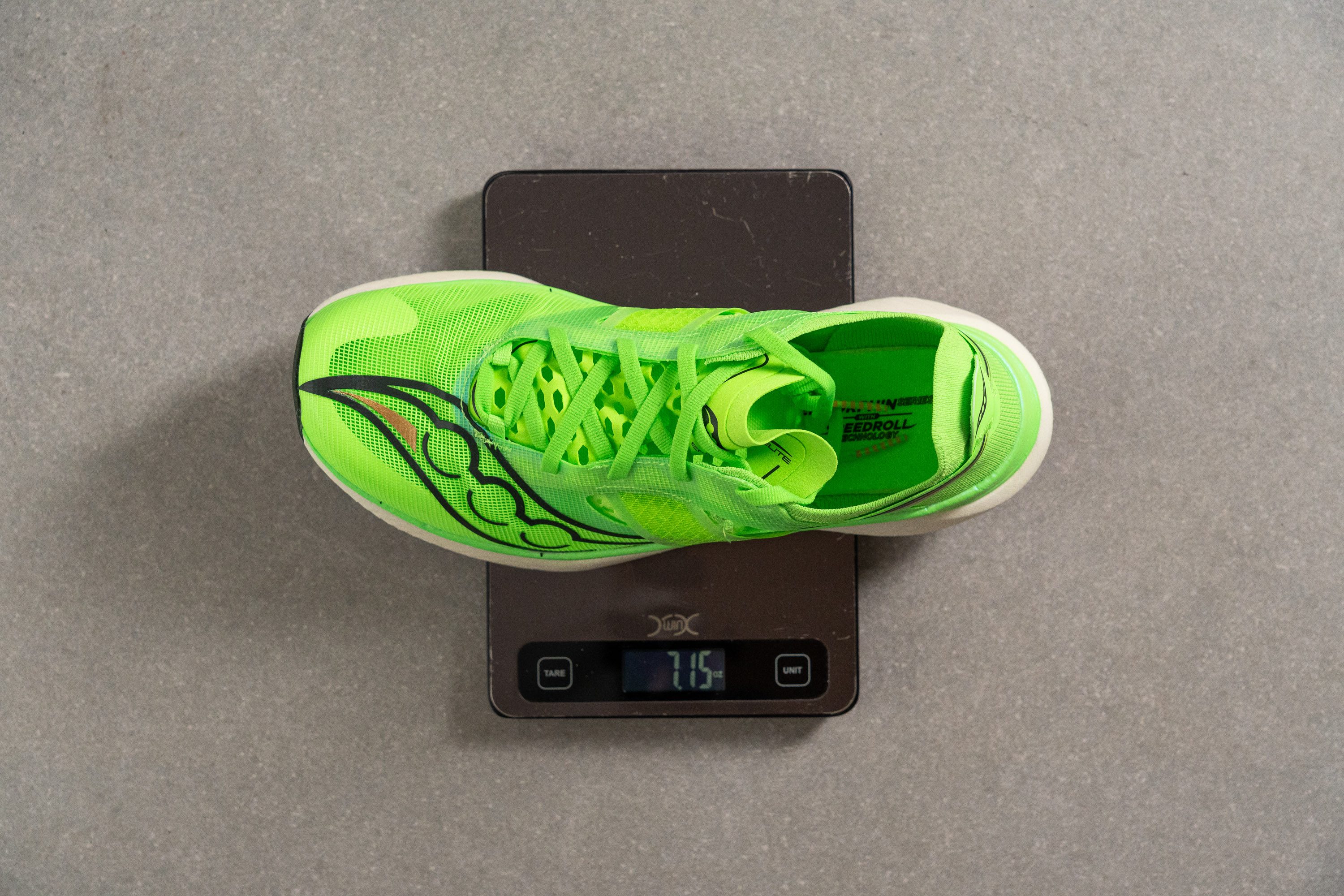
Based on our running and lab experience, we recommend shoes that weigh less than ~9.5oz or 270g. Of course, we get to see runners doing marathons in, for example, Asics Gel Kayano 30 which weighs 10.7 oz or 303g, but it’s a daily trainer and we stick to the general guidelines.
Breathability levels of marathon running shoes
In RunRepeat lab, we fill the shoes with smoke and watch where the smoke comes out and at which pace. Based on this, we rate the breathability on a 1-5 scale, where 5 is the most breathable.
Different breathability levels recorded in RunRepeat lab
One could think that 5/5 is the best rating to get and 1/5 the worst. However, while 5/5 is perfect for summer and sweaty feet, 1/5 is great for running in very cold weather. All the heat stays inside so your toes don’t freeze.
 Extremely breathable (rating 5/5) upper and a non-breathable upper (rating 1/5) under the microscope
Extremely breathable (rating 5/5) upper and a non-breathable upper (rating 1/5) under the microscope
Some general guidelines are: 1/5 is great for cold weather (such shoes often have waterproof membranes) and 5/5 is perfect for summer. 3/5 is the middle ground and can go both ways - it’s bad if your feet sweat a lot and it’s warm, and it’s bad if your feet get cold easily and it’s cold outside.
Durability of marathon running shoes
There are some premium marathon race shoes that are made for 1 marathon only. There are other shoes that are more durable. Overall, these shoes can be split into 2 groups:
- Shoes that are used for race ONLY because they are expensive and not so durable
- Shoes that are used for race but ALSO for training prior to the race
In our lab, we measure the durability of 3 different parts of a running shoe. But, it’s also important to consider how durable the midsole is, or when it bottoms out and is no longer performing as it should. This is something we can’t measure (yet) but we did cover it in our foams guide.
Now, onto the measurements. Using a Dremel, we test the durability of
- Toebox. Especially important if this is the part of the shoe that usually gives up on you first or if your big toe is pointing up and has a good chance of making a hole in the upper.
- Heel padding. This one resonates with runners who don’t use a shoe horn or whose heel often rubs the padding to the level of damaging it.
- Outsole. No outsole, no grip. Also, no protection for the midsole. In most cases, when the durability of the shoe is discussed, runners first think of the outsole.
Non-durable upper (rating 1/5) on the durability test
For the first 2 tests, we assess the damage and assign a durability score on a 1-5 scale, where 5 is the most durable.
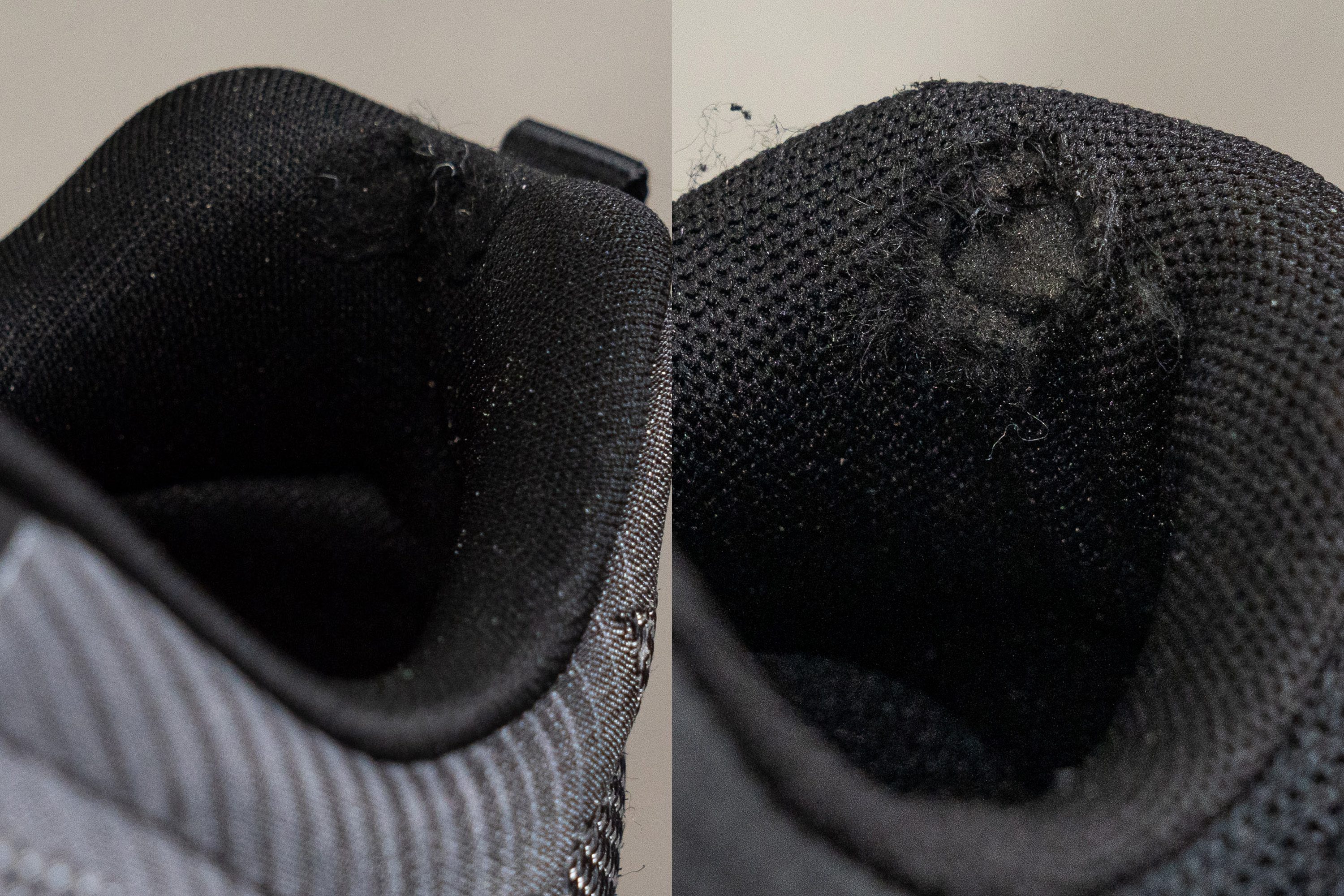
When it comes to the durability of the outsole, we’re able to precisely measure the dent made by the Dremel and we use a tire tread gauge to do that.
The deeper the dent, the less durable the outsole is.
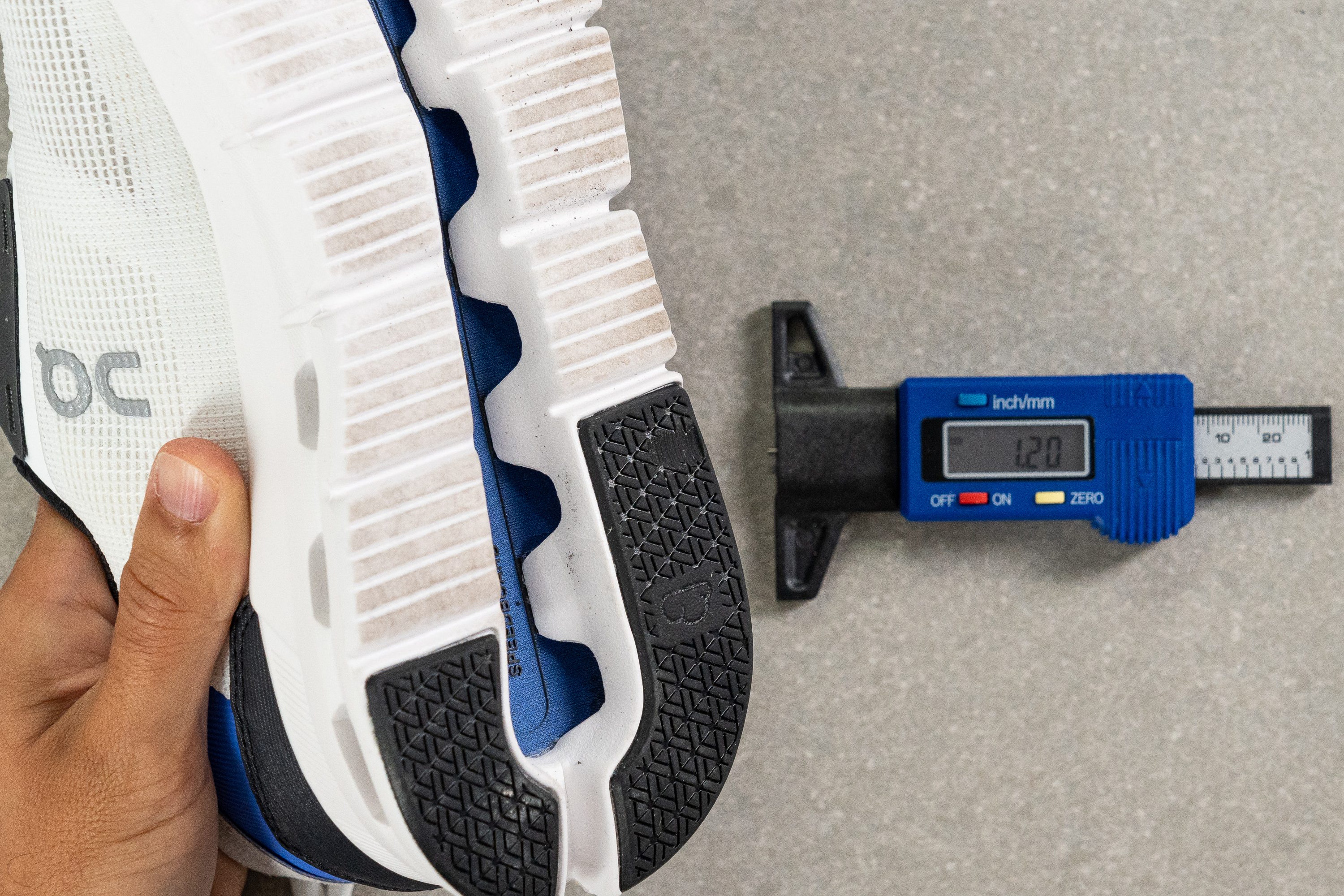
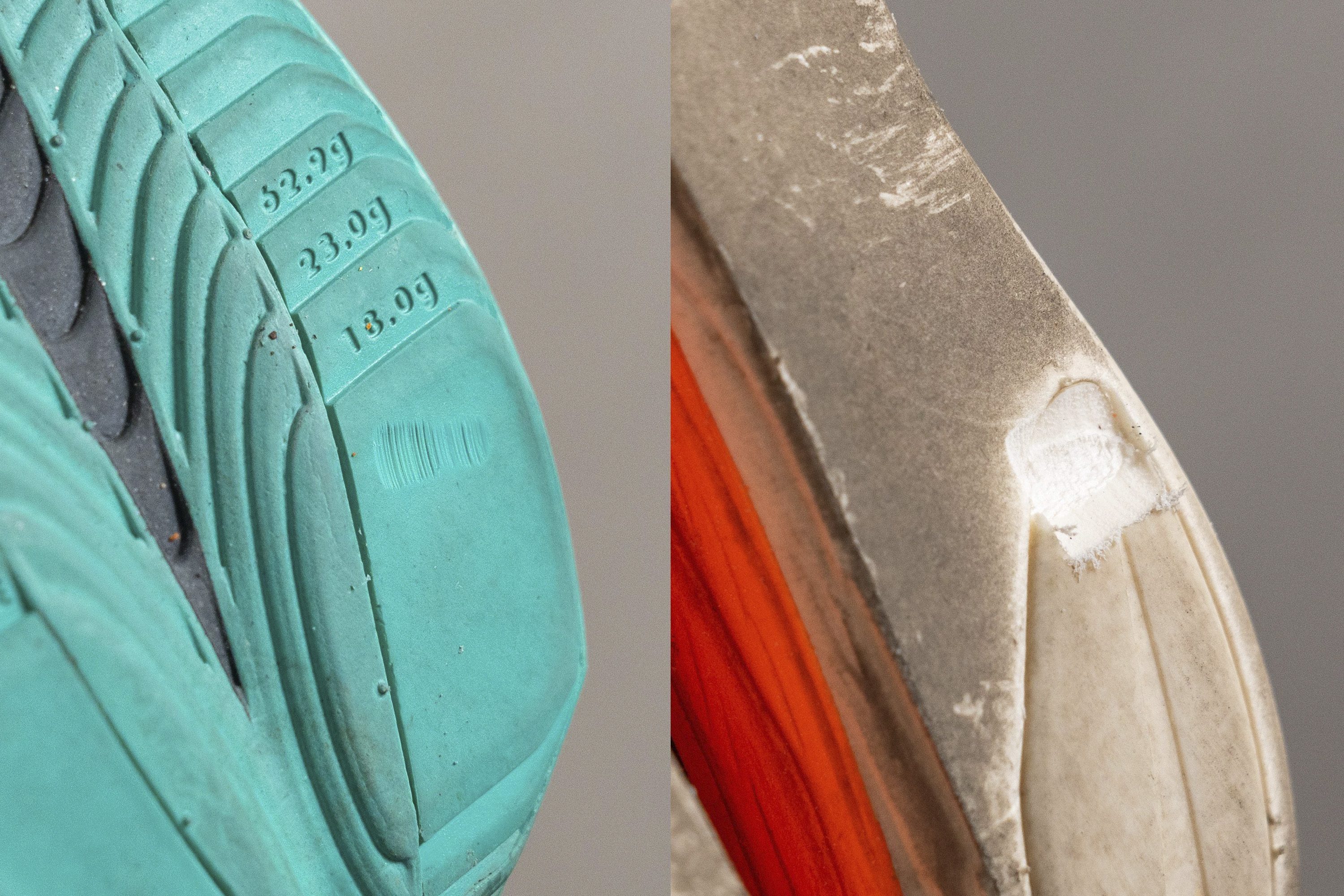
When it comes to the durability of the outsole, we also measure the hardness of the outsole. As a general rule, softer rubbers are stickier and more flexible, and harder rubbers offer more protection and durability.

Stiff or flexible: what’s better for marathons
Shoes that are carbon-plated are very stiff and they work wonders, in combination with amazing foams, when it comes to responsiveness. But, not all shoes are carbon-plated, and not all shoes are as stiff. However, stiffness does help on the long runs, because the shoe bends less and therefore, your feet work less.
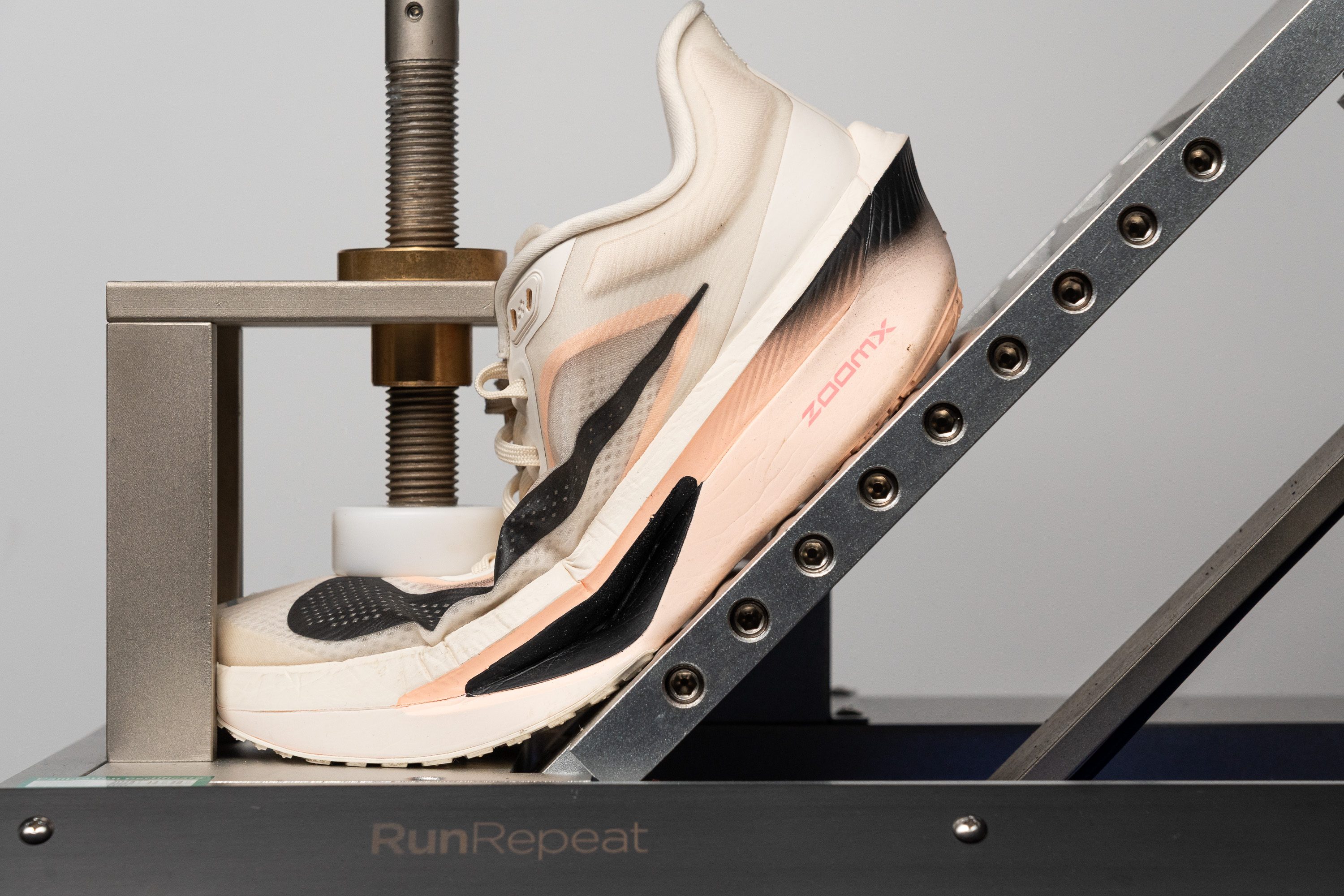
Very flexible shoes promote a more natural feeling when running because our feet are very flexible, but when it comes to longer distances, like a marathon, stiffness helps. There’s no premature fatigue and the shoes feel more stable and secure.
Stiffness test is done like this:
- we lock the toebox in place, which lifts the heel slightly due to the forefoot rocker
- to adjust for the rocker, we move the bottom plate so that the heel rests on it
- then we bend the shoe to 30 degrees and measure how much force was needed to bend it
Less force needed means more flexible running shoes!
Here’s an overview of best-rated marathon shoes and their flexibility (note that the higher the number, the stiffer the shoe):
How stable are marathon running shoes
Because they are often high-stacked (tall), their stability can become questionable. It depends on how squishy the foam is and how wide the base is. Firmer foams and wider bases are recommended for those who want more stability.
Noticeably soft foam in Nike ZoomX Streakfly but the shoe is not that tall
It’s important to understand how soft the foam is and whether the shoe is stable enough, especially for heel strikers. Some work best for runners who land on the forefoot, not just because of the stability but because the plate is activated better to propel the runner forward.
Very soft foam, very narrow platform, very high stack height
This is another test where we use a digital caliper: to measure the width of the base at the forefoot and at the heel. The width of the base is especially important for heel strikers which is why we prioritize it in the table below.
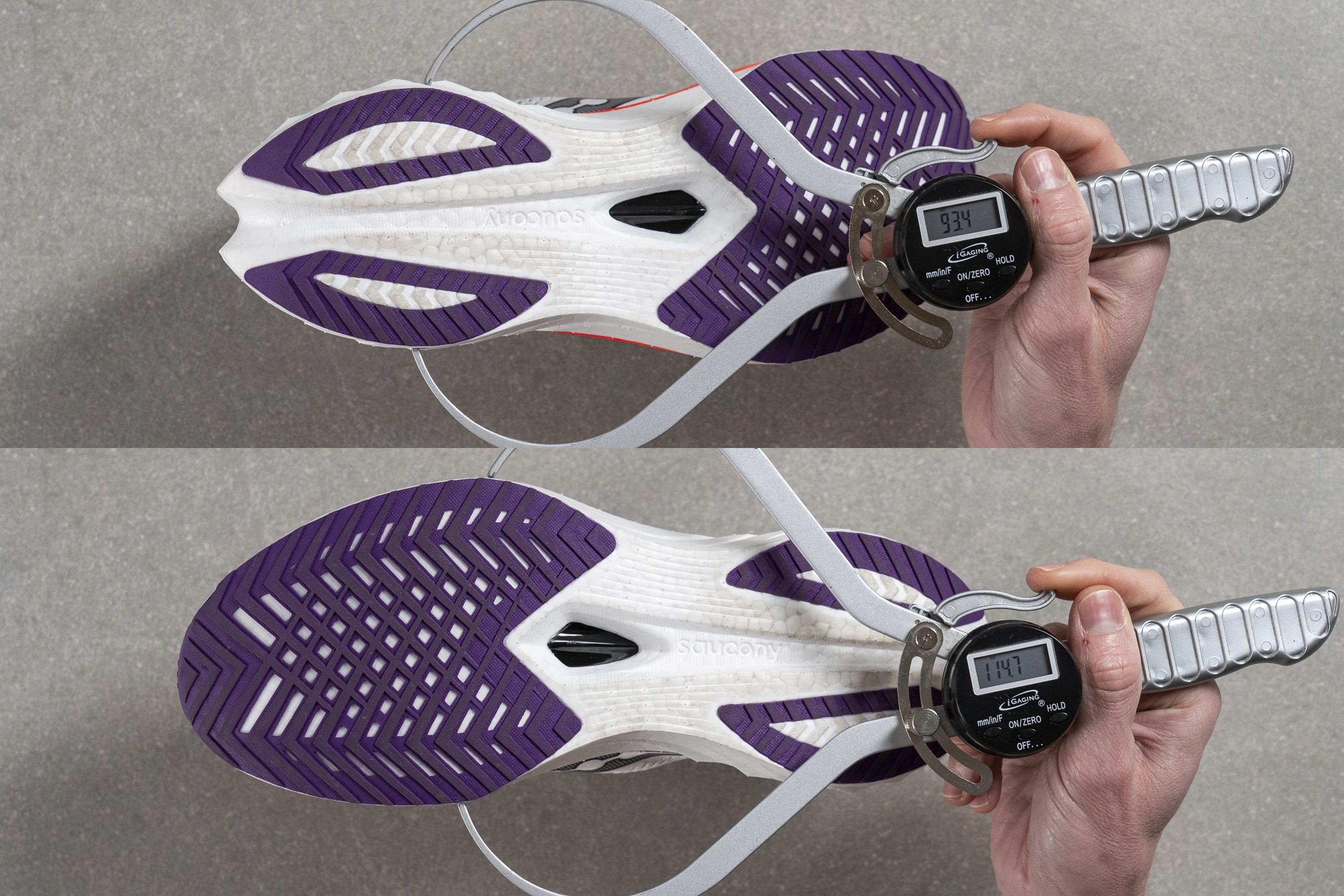
Keep in mind that here, we’re talking about how stable the shoe is for any runner. If you’re overpronating and need stability shoes, then you should look for stability elements (stability running shoes).
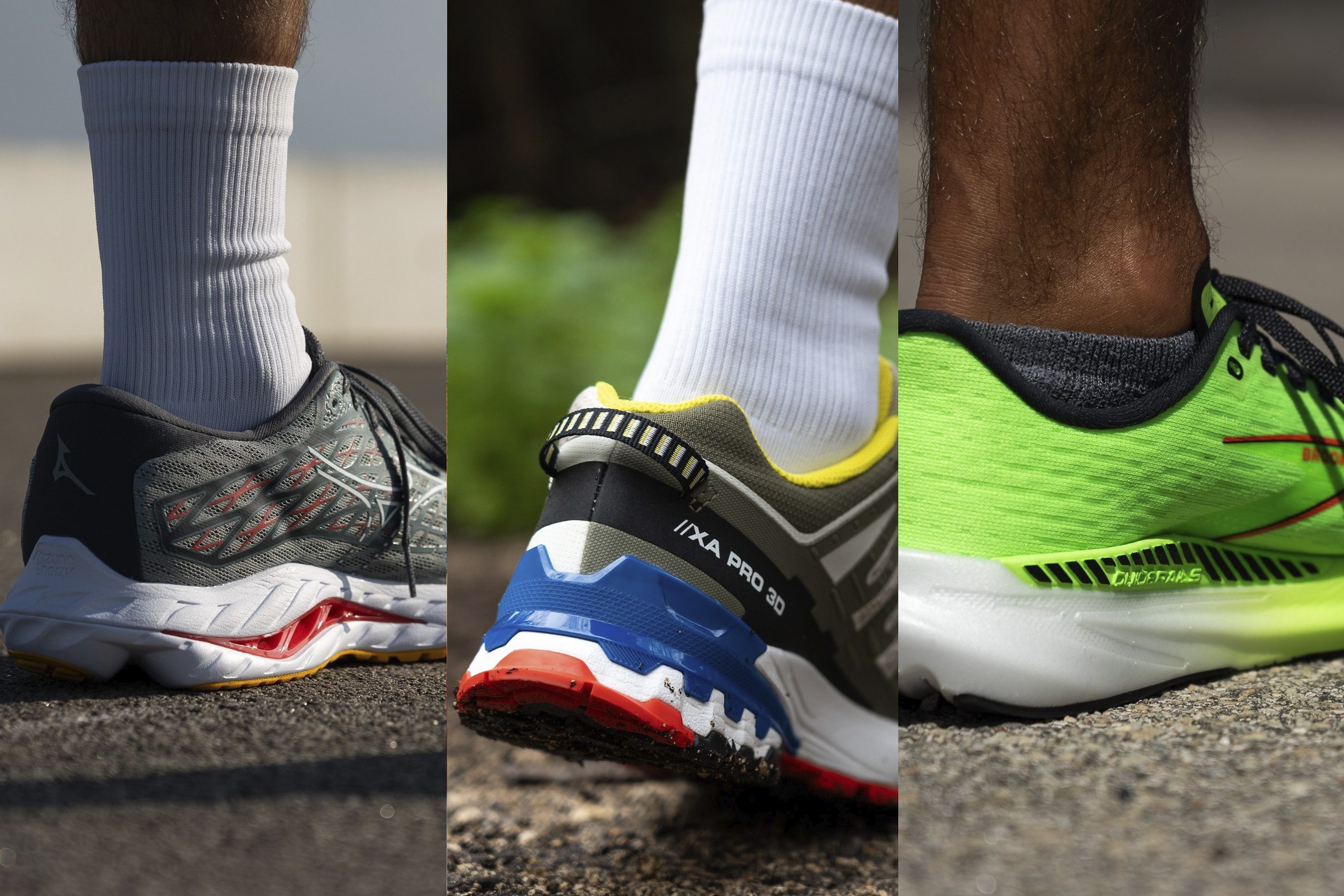
|
For those who want to learn more about pronation (overpronaiton, supination) and shoes for each condition, we recommend reading our guide: Pronation 101: Running Shoe Choices, DIY Analysis, Injuries. |
Foot strike and marathon running shoes
Still figuring out your foot strike and how it impacts your running form and economy? We got you covered: Foot Strike: The Ultimate Guide.
Marathon running shoes, especially the elite ones, can suit both forefoot and heel strikers, but also can work better for one strike only. If you’re not sure, you can always check our filters and tags. Or, look for these features below.
Forefoot/midfoot strikers should look for:
- Enough cushioning at the forefoot to protect them from the impact
- Heel drop that’s lower than 10mm
- Great outsole rubber coverage at the forefoot.
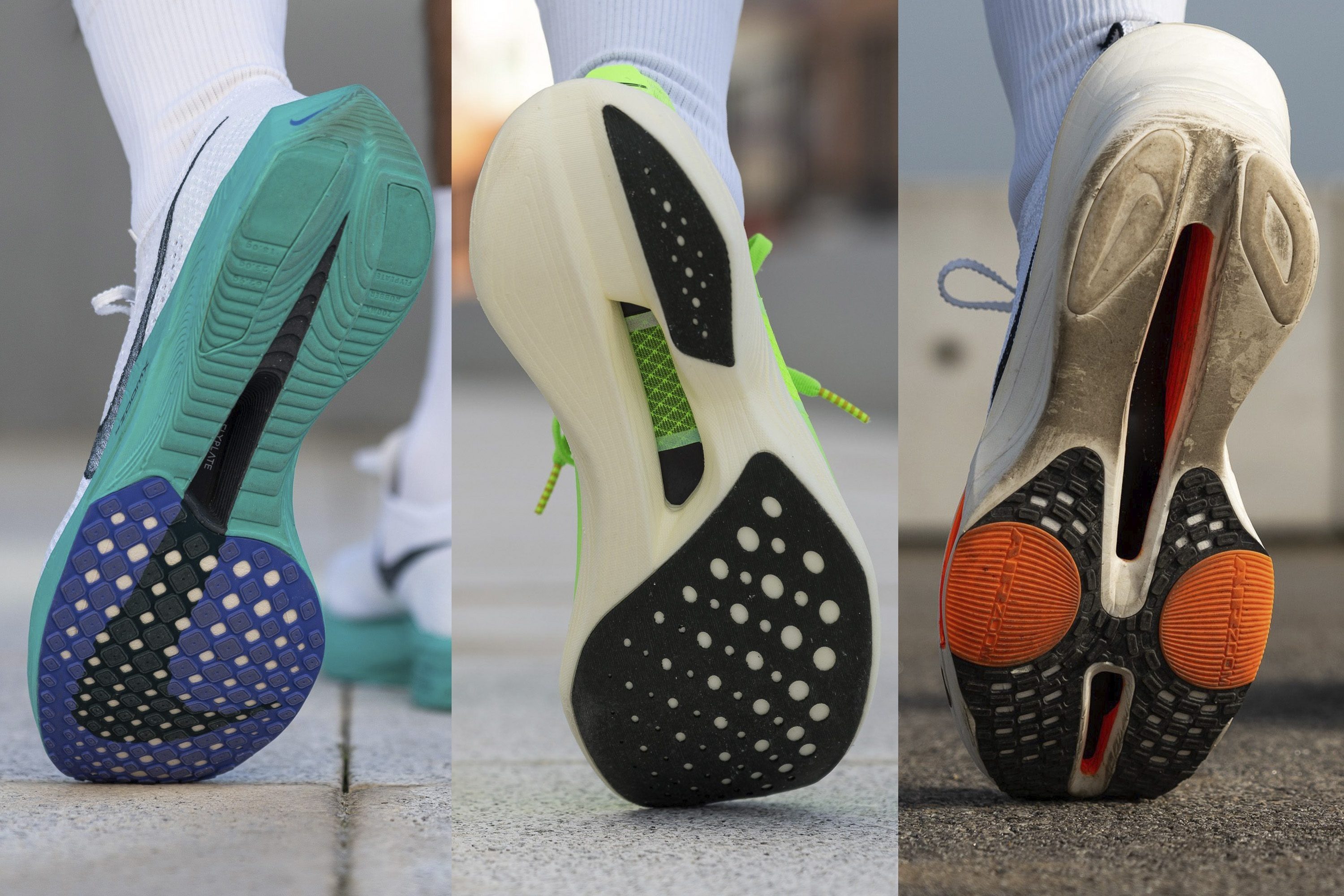
Heel strikers should look for:
- Cushioned heel
- Stable shoes, especially if they are very high, the base should be wide at the heel
- Heel drop of at least 8mm
- Great outsole rubber coverage at the heel.

When to get carbon-plated marathon running shoes
These shoes, as the name suggests, have a carbon fiber plate embedded in the midsole.
Showcasing a carbon fiber plate on a shoe cut in half
The plate makes the shoe stiffer but also helps with responsiveness. It’s usually found in more expensive running shoes and almost always in elite race shoes.
Full-length carbon fiber plate taken out from the midsole
When to get carbon-plated marathon running shoes:
- You’re a (somewhat) experienced runner and you can keep a good pace
- You’re looking at breaking a new PB
- You can afford them even though they might not be as durable as non-plated shoes
- You have time to adjust to their perks (possibly favoring forefoot strike, instability at slow paces and cornering)
When NOT to get carbon-plated marathon running shoes:
- You are a beginner
- You’re still not familiar with different foot strikes (many plated shoes work better for forefoot strikers)
- You’re not ready to keep the pace high because many plated shoes feel odd when walking or jogging
| In case you want to learn more (everything) about running shoes with a carbon-fiber plate, we suggest going down the rabbit hole with us: Carbon-Plated Shoes Cut In Half, Explained and Lab-Tested. |
Rocker: Yay or nay?
Rockered geometry certainly feels great as it makes the transitions smoother (like a rocking chair), but it is not recommended for everyone.
Very rockered New Balance SuperComp Trainer vs. Adidas Adizero Adios 7
Many shoes feature a rocker of some kind today, it just depends on how noticeable/aggressive it is.
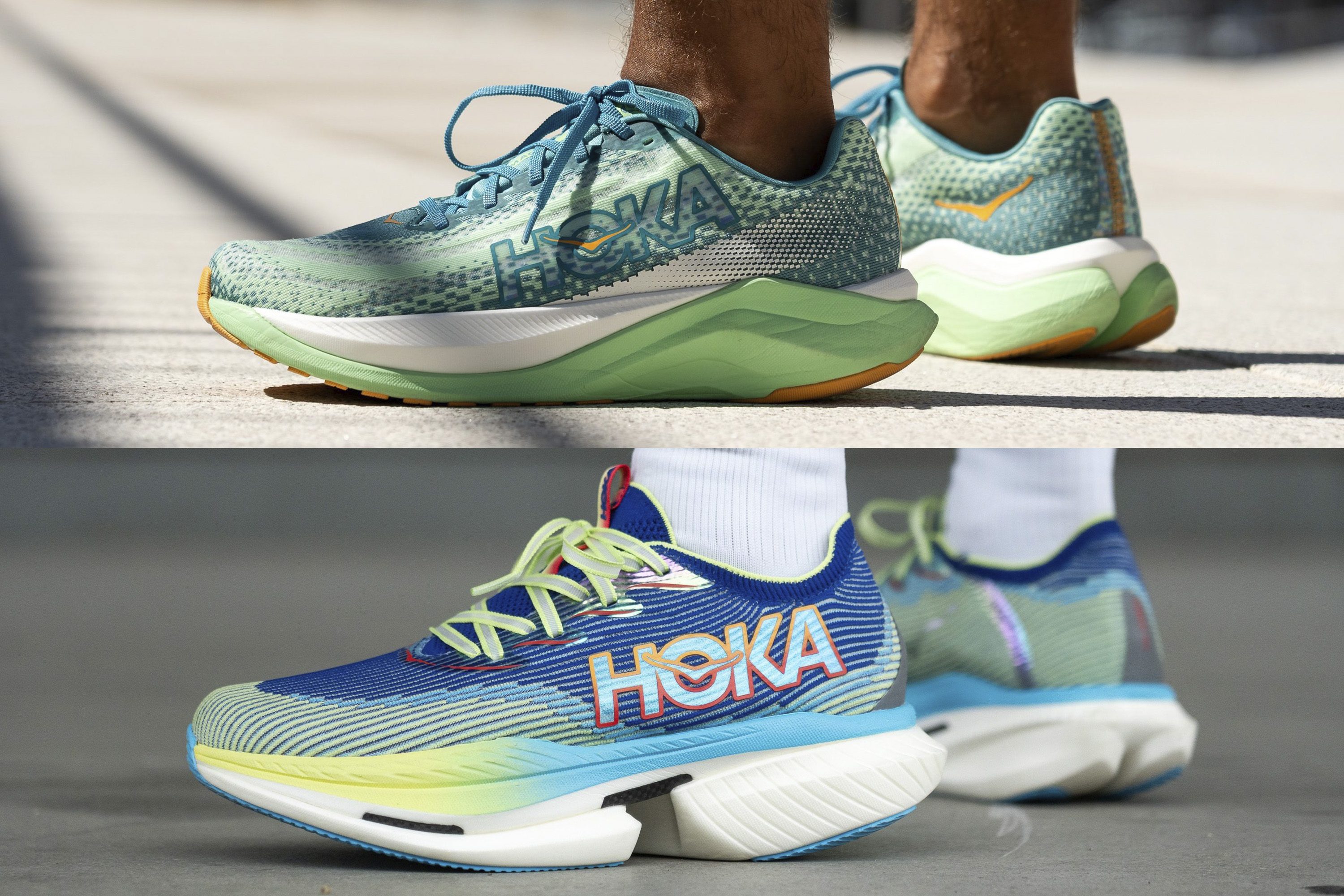
Rockered running shoes could feel great for you if:
- You’re experiencing heel pain, plantar fasciitis, toe or forefoot pain, Achilles tendon issues, limited big toe extension
- You’re an older runner as rockered running shoes might reduce strain in ankle, foot and toe joints
- Simply, they feel good.
Many heel strikers enjoy the rockered shoes.
You might want to avoid rockered running shoes if you’re experiencing issues/injuries with your knee or hips like ITBS, runner’s or jumper’s knee, meniscus tears, hip flexor strain or hip bursitis. Also, forefoot strikers usually prefer flatter geometry in running shoes.
|
And if you’re into these geeky details and want to learn even more about rockers in running shoes, we wholeheartedly recommend our guide All You Need to Know About Rockered Running Shoes. |

